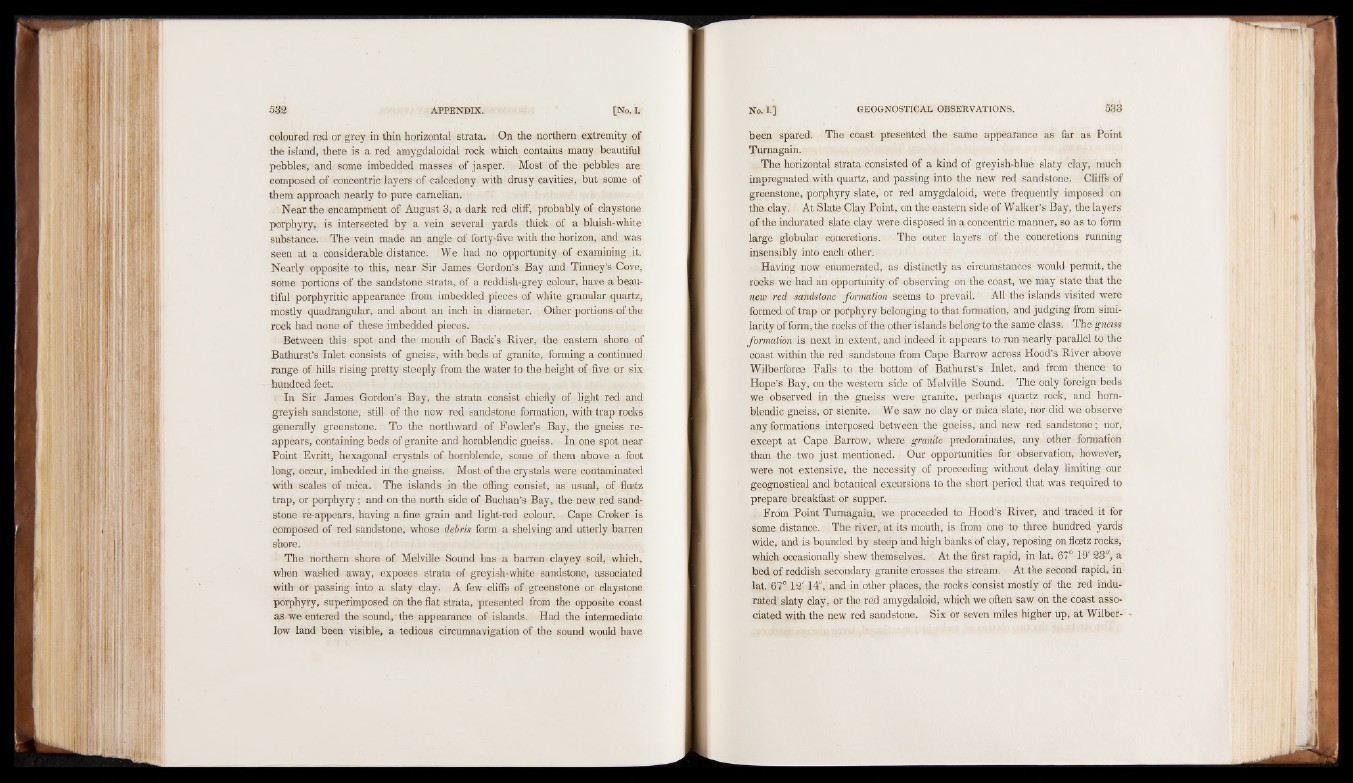
coloured red or grey in thin horizontal strata. On the northern extremity of
the island, there is a red amygdaloidal rock which contains many beautiful
pebbles, and: some imbedded masses of jasper. Most of the pebbles are
composed of concentric layers of calcedony with drus'y cavities, but some of
them, approach nearly to pure earnelian.
. Near the encampment of August 3, a dark red cliff, probably of claystone
porphyry, is intersected by a vein several yards thick of a bluish-white
substance. The vein made an angle of forty-five with the horizon, and was
seen at a considerable distance. "We had no opportunity of examining it.
Nearly opposite to this, near Sir James Gordon’s Bay and Tinney’s Cove,
some portions of the sandstone.strata, of a reddish-grey colour, have a beautiful
porphyritic appearance from imbedded pieces of white granular quartz,
mostly quadrangular, and about an inch in diameter. Other portions of the
rock had none of these imbedded pieces.
Between this spot and the mouth of Back’s River, the eastern shore of
Bathurst’s Inlet consists of gneiss, with beds, of granite, forming a continued
range of . hills rising pretty steeply from the water to the?height of five, or six
hundred feet.
In Sir James Gordon’s Bay, the strata consist chiefly of light red and
greyish sandstone, still of the, new red sandstone formation, with trap rocks
generally greenstone. To the northward of Fowler’s Bay, the gneiss reappears,
containing beds of granite and hornblendic gneiss. In one spot near
Point Evritt, hexagonal crystals of. hornblende, some of them above a foot
long, occur, imbedded in the gneiss. Most of the crystals were contaminated
with scales of mica. The islands in the offing consist, as usual, of floetz
trap, or porphyry; and on the north side of Buchan’s Bay, the new red sandstone
re-appears, having a fine grain and light-red colour. Cape Croker is
composed of red sandstone, whose debris form a shelving and utterly barren
shore.
The northern shore of Melville Sound has a barren clayey soil, which,
when washed away, exposes strata of greyish-white sandstone, associated
with or passing into a slaty day. A few cliffs of greenstone or daystone
porphyry, superimposed on the flat strata, presented from the opposite coast
as. we entered the sound, the appearance of islands. Had the intermediate
low land been visible, a tedious circumnavigation of the sound would have
been spared. The coast presented the same appearance as far as Point
Turnagain.
The horizontal strata consisted of a kind of greyish-blue slaty clay, much
impregnated with quartz, and passing into the new red sandstone. Cliffs of
greenstone, porphyry slate, or red amygdaloid, were frequently imposed on
the clay. At Slate Clay Point, on the eastern side of Walker’s Bay, the layers
of the indurated slate clay were disposed in a concentric manner, so as to form
large globular concretions. The outer layers of the concretions running
insensibly into each other.
Having now enumerated, as distinctly as circumstances would permit, the
rocks we- had an opportunity of observing on the coast, we may state that the
new red sandstone formation seems to prevail!®: All the islands visited were
formed of trap or pofphyry belonging to that formation, and judging from similarity
of form, the rocks of the other islands belong to the same class. The gneiss
formation is. next in extent, and indeed it appears' to run nearly parallel to the
coast within thé red sandstone from Cape Barrow across Hood’s River above
Wilberforce Falls to the bottom of Bathurst’s Inlet, and from thence to
Hope’s Bay, on the western side of Melville Sound. The only foreign beds
we observed in the gneiss were granite, perhaps quartz rock, and hornblendic
gneiss, or sienite. We saw no clay or mica slate, nor did we observe
any formations interposed between the gneiss, and new red sandstone; nor,
except at Cape Barrow, where, granite predominates, any other formation
than the two just mentioned. Our opportunities for observation, however,
were not extensive, the necessity of proceeding without delay limiting our
geognostical and botanical excursions to the short period that was required to
prepare breakfast or supper.
From Point Turnagain, we proceeded to Hood’s River, and traced it for
some distance. The river, at its mouth, is from one to three hundred yards
wide, and is bounded by steep and high banks of clay, reposing on floetz rocks,
which occasionally shew themselves. At the first rapid, in lat. 67° 19' 23", a
bed of reddish secondary granite crosses the stream. At the second rapid, in
lat. 67° 12' 14", and in other places, the rocks consist mostly of the red indurated
slaty clay, or the red amygdaloid, which we often saw on the coast associated
with the new red sandstone. Six or seven miles higher up, at Wilber